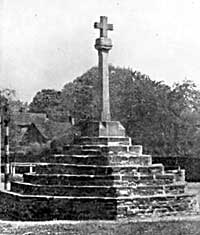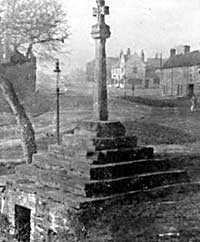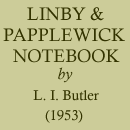< Previous | Contents | Next >
Linby Rectory

Top Cross, Linby.
The original Rectory House was probably built some fifty years before the Reformation, since it is mentioned among the assets in the Valor Ecclesiasticus of Henry VIII, and it has been considerably enlarged since that time.
The oldest part lies to the north west of the present building, and has beneath it some wonderful cellars excavated from the solid rock. In this part of the Rectory the windows have stone mullions, and there are traces of at least two staircases now out of use. It began as a small rectangular building of four bays, and later had a wing built on the south making it L-shaped; this is shown on an old Tithe Map of 1841. Then in 1856 the Rev. J. L. Prior obtained a mortgage for further building, adding a wing which made it a rectangular building once more. The dimensions are approximately a rectangle with sides eight-four feet by fourty-four feet. The gable on the newest part carries a bell made by Abner and Sons of London bearing the date 1855.
The value of the benefice given in the Taxation of Pope Nicholas (1292) is:—Ecclia de Lyndeby P' T' Pens' £5. Pens' Prioris de Lenton in eadem ecclia 6s. 8d.
The Papplewick entry of the same period, reads:— Ecclia de Papilwik. Mon de Novo loco appiat £3 6s. 8d.
The relevant extract from the Valor Ecclesiasticus of Henry VIII. 1535 gives the following details:—
Lyndeby Rectory. Thomas Dunwell Rector.
Is valued in a house with two bovates of land at 13/4d. a year. In Easter tenths 18/4. Tenths of corn and hay 43/4. In tenths of pigs, ducks, and hens 3/4. In the four days oblations 10/-. And in tenths of wool and lambs 12/4d. In the whole 100/4d. Charge for Synod 4/-. For procurations 6/8d. per annum. There remains £4/9/8. One tenth 6/8 per annum.Lenton Priory has a pension from the Church of Lynby 6/8d.
In 1714 the Terrier in the York Registry gives the following information as to the belongings of the benefice, but not the income.
Terrier of the Gleab Land and Houses belonging to the Rectory of Linby.
Imprimis a dwellinghouse 4 bayes. Item one barne of four bayes built by ye present incumbent in ye year 1706. Item a stable of two bays. Item a Croft garden and orchard and ye fold yard containing an acre. Item a close going to Hucknall field side containing 13 acres and on the other side of ye hedge in Hucknall field half an acre of plowland. Item in the meddow five roods, in the pingle three roods. Item two beasts pastures in Cunghill ye comon pasture.
Linby Crosses

Bottom Cross, Linby.
Most villages could boast of having a village cross, but ours is lucky in having two. The Top Cross, which was the normal village cross, was restored in 1869, its previous destruction dating back to the vandalism of the Commonwealth period. The base is ancient and original; original also in being probably the only example of a even-sided base in the county, and perhaps the country. There are seven steps to the bottom of the cross, arranged in pyramid, with each side of the bottom step about eight feet long. The diameter of the base is about six yards, and the height of the pyramid about seven feet. The existence of a cross in Linby is mentioned in the Forest Perambulation of 1538 and may refer to this one. The extract reads:—
From Lynby Mill to the Cross, thence along the Great Road, leaving Annesley Castle on the right, thence to Scholegate as far as Chesterfield Ledeyate....
The Bottom Cross has been variously dated, one interpretation of the mutilated date being given as 1469, while another and more probable date suggested is 1660; a date much defaced but still partially visible on the capitol appears to be 1663. This later date seems a better guess, since the cross may well be one of the many erected as a mute testimony to the Restoration. The Cross, at the back of which used to lie the village Pound, is set on a square base through which runs one of the village streams which join the Leen, symbolising the Living Water through the Cross of Christ.
This Cross has six steps, a plinth a capitol, and a small cross eighteen inches high, having a crosslet in relief. The head and arms of the cross have triple finials.
Linby Hall (Farm)
In Hall Farm we probably have left the remains of the old Manor House, built when the estate known as the "manor of Linby" had become really a manor in the modern sense. In the early days there were most likely three estates in Linby, belonging to the three brothers mentioned in Domesday. After the Conquest these seem to have been merged into two, one moiety belonging to the King, the other let or granted to sundry tenants. The two estates may reasonably be accounted for by the fact that the northern part of Linby was within, while the southern part was without the metes and bounds of Sherwood Forest. In a letter to the late Rector, the Rev. A. B. Reid, the late W. H. Stevenson communicated the following information. "The Hall as it now is, is really a western extension of an older Hall which had a south aspect, and which adjoined the back of the present building. The length of the present Hall was determined by the desire for a gallery or long room on the first floor, with rooms for lodgment above; and store rooms, dairies, and the like below. In that long room was a great open firepace sunk in the back wall, carried in a chimney shaft of great size on brackets, or stone corbels which are still (1915) in evidence. Partition walls have since been built and when the old fireplace fell out of use it was converted into a closet in the wall. In the early days when the Hunts were in occupation, and following them the Strelleys, the Hall was probably L shaped, with a first floor at its western part, abutting on the back of the present Hall Farm. This is shewn by the outward indications of a circular staircase, a fashion which went out in the time of Henry VII. The newer portions were probably added in the time of Sir Nicholas Strelley say about 1495 when he attained his majority. Following the death of Sir Nicholas Strelley, the manor of Lynby was leased to George Chaworth, brother of John Chaworth, Knight, of Wiverton, and whose son John Chaworth of Cropwell Butler, or his grandson George, Viscount Armagh, became head of the Chaworth family through failure of the senior line. From the Strelleys the estates passed to the Staveleys in about 1535, and at some time before 1577 from the Stavelevs to a Mr. Savile, who exchanged for land at Oxton with Sir John Byron who owned that part of Lynby previously belonging to Newstead Priory."
